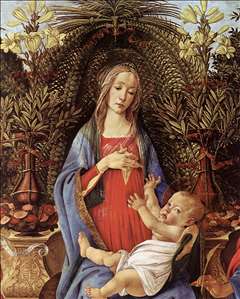Florentine painter (original name Alessandro di Mariano Filipepi), neglected for centuries but now probably the best-loved painter of the quattrocento. The name Botticelli , meaning little barrel , was originally given to an older brother, presumably because he was portly, but it became adopted as the family name.
Sandro trained with Filippo Lippi, who was the most important influence on his style. By temperament he belonged to the current of late 15th-century art which reacted against the scientific naturalism of
Masaccio and his followers and revived certain elements of the Gothic style - a delicate sentiment, sometimes bordering on sentimentality, a feminine grace, and an emphasis on the ornamental and evocative capabilities of line. Almost all Botticelli s life was spent in Florence, his only significant journey from the city being in 1481-82, when he worked on the decoration of the Sistine Chapel in the Vatican, where he painted side by side with
Perugino, Rosselli, and Ghirlandaio. The fact that he was called to Rome for such a prestigious commission shows that he must have had a considerable reputation, and by this time the most characteristic idiosyncrasies of his style had already gained shape in the celebrated poetic allegory known since
Vasari as the Primavera (Uffizi, Florence, c. 1478). There is evidence that the patron who commissioned this and two of his other famous mythological paintings (The Birth of Venus and Pallas and the Centaur, both in the Uffizi) was Lorenzo di Pierfrancesco de Medici (second cousin of Lorenzo the Magnificent), a wealthy Florentine with strong interests in Platonic philosophy. It has been suggested that it was this philosophy that prompted the new idea of large-scale pictures with a secular content; the classical deities represented are not the carefree Olympians of Ovid s tales but the symbolic embodiment of some deep moral or metaphysical truth. Given that the Neo-Platonists regarded Beauty as the visible token of the Divine, there would be no blasphemy in using the same facial type and expression for Venus and for the Holy Virgin.
According to Vasari, Botticelli later fell under the sway of Savonarola s sermons, repented of his pagan pictures, and gave up painting. The final part of this statement is definitely incorrect and the rest is doubtful, but it is certainly true that Botticelli s later paintings (e.g. the Lamentation in the Alte Pinakothek, Munich, and the Mystic Crucifixion in the Fogg Art Museum, Cambridge, Massachusetts) are more obviously serious - solemn, intense, sometimes ecstatic - than his early work. The most telling example is the Mystic Nativity (National Gallery, London, 1500), which bears a cryptic inscription seeming to imply that Botticelli expected the end of the world and the dawn of the millennium.
Botticelli ran a busy studio (his most important pupil was Filippino Lippi) and his surviving output is large for a painter of his period. Apart from religious and mythological pictures, he produced some memorable portraits and also some marvelously delicate drawings - mainly in pen outline - for a lavish manuscript of Dante s Divine Comedy (now divided between the Staatsbibliothek, Berlin, and the Vatican Library). Although little is known of his life, it seems clear that at the peak of his career he was the most popular painter in Florence. His patrons included some of the city s finest churches and most distinguished families, and several of his paintings (particularly those on the theme of the Virgin and Child) exist in several versions or copies, attesting to the vogue they enjoyed. He worked for the great families of Florence, especially the Medici family, for whom he painted portraits, most notably the Giuliano de Medici (1475-1476, National Gallery of Art, Washington). The Adoration of the Magi (1476-1477, Uffizi, Florence) was painted on commission (though not for the Medicis), and contains likenesses of the Medici family as well as a likeness of himself.
Botticelli also painted religious subjects, especially panels of the Madonna, such as the Madonna of the Magnificat (1480s), Madonna of the Pomegranate (1480s), and Coronation of the Virgin (1490), all in the Uffizi, and Madonna and Child with Two Saints (1485, Staatliche Museen, Berlin). Other religious works include Saint Sebastian (1473-1474, Staatliche Museen) and a fresco, Saint Augustine (1480, Church of the Ognissanti, Florence). In 1481 Botticelli was one of several artists chosen to go to Rome to decorate the walls of the Sistine Chapel in the Vatican. There he executed The Youth of Moses, the Punishment of the Sons of Corah, and the Temptation of Christ.
After
Leonardo s return to the city in 1500, however, Botticelli s linear style must have looked archaic and he died in obscurity. His fame was not resurrected until the second half of the 19th century, when the Pre-Raphaelites imitated his wan, elongated types, Ruskin sang his praises, and Walter Pater dedicated to his art one of his most eloquent essays. At the end of the century his work was a major influence on Art Nouveau.









